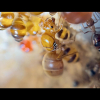I had taken the colonies out of hibernation around mid-November. Striking differences are appearing between the two colonies, so I will comment on both colonies separately.
Colony 1: This queen was found trying to invade a Formica podzolica nest.
This colony has a real mix of workers from my boosting in the fall. About 12-16 Formica podzolica, 5-8 Formica aserva, and 3-4 Formica ulkei.
I have not noticed any problems amongst the workers, although one very high strung aserva worker who is missing half of one antennae rarely accepts a cleaning from her nest mates.
This colony is extremely easy to feed with the aggressive Formica aserva. One is almost always in the foraging area, and the aserva actively hunt fruit flies (or anything that they even think might have moved). Once food is found, it usually enlists 2 other aserva, and they are usually followed by a runty Formica podzolica with an attitude to match the aserva.
2 weeks ago the first eggs appeared. There are currently about 18-25 eggs being carried around by a ulkei worker.
Colony 2: This queen was found in the grass, presumably trying to find a Formica ulkei nest that I suspect is around there somewhere. This queen is also more restless than the other queen, about 2-3 times a week she goes to the entrance of outworld before retreating back into the nest.
This colony had a mix of workers: 18-20 Formica podzolica workers, 1 Formica aserva, 3 Formica ulkei.
I am not sure if it was the large ratio of podzolica workers to the other species, or just 1-2 individuals with sharp instincts, but these workers were not that peaceful towards the ulkei workers in the long duration.
Before hibernation, all of them were peaceful with no issues that I saw. After I took them out of hibernation I started seeing some aggression from the podzolica workers towards the ulkei workers. If a podzolica worker approached the ulkei from the front and they touched antennae, all was fine. But if the podzolica worker approached from behind and touched the ulkei's very hairy gaster, then it reacted a bit aggressively. Some of the podzolica workers were shy and just skittered away, but 1-2 of the larger and more aggressive ones would try to bite the ulkei's gaster. In the end, one particularly large Formica podzolica worker grabbed the ulkei worker by her petiole and simply wouldn't let go. After 4-5 days the ulkei worker died, and the podzolica worker would find another ulkei worker to grab. After a month, all of the 3 ulkei workers were dead. Interestingly, the podzolica never had a problem with the aserva. Perhaps because they lacked the hairy gaster that the ulkei have? I am not sure.
I have not seen any aggression towards the queen - although I am beginning to suspect that the queen's wings remain intact as a survival mechanism, as the smooth wings shield her very hairy gaster. The workers in this colony have trimmed the queens wings a bit, they extend to the tip of her gaster, but not beyond.
The lone aserva in this nest is fairly small compared to their usual size. It is also a wimp. I have never seen it in the foraging area, although it will readily attack a fruit fly if one dares to crawl into the nest. The aserva's refusal to leave the nest, and the fairly shy podzolica make feeding this colony hard. Luckily the nest entrance is a bit higher than then outworld entrance, so if I place a fruit fly in the tunnel, it will usually crawl up and into the nest.
This colony does not have any eggs yet.





































